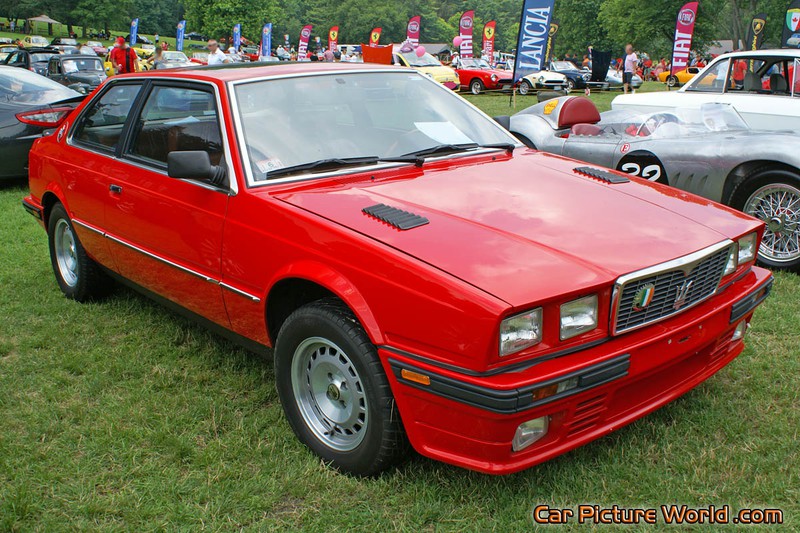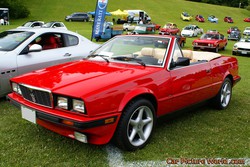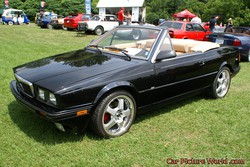Biturbo Pictures by Model

Maserati Biturbo
The Maserati Biturbo was a family of luxury sports cars produced by Maserati between 1981 and 1994. The original Biturbo was a two-door, four-seater notch-back coupé equipped with a two-liter V6 engine with dual turbochargers.
History
The Biturbo was designed as a more affordable Maserati and it was initially a strong seller with sales of about 40,000 units. Sales fell in subsequent years.
The Maserati Biturbo was the first ever production car with a twin-turbocharged engine. The aluminum 90-degree SOHC V6 engine was roughly based on the 2.0 L Merak engine, itself based on earlier V8 Formula One Maserati engines.
Many variations of the Biturbo were made, including the 2.24v., the 420, 425 and 430, the Spyder, the Karif, the 228, the Shamal, the Ghibli II, and the Barchetta.
Between 1987-89 a facelift was phased in, which helped to soften the sharp body lines. In 1988 the Biturbo name was dropped in favor of 222-meaning 2-door, 2-liter engine and 2nd generation. In 1991 the entire lineup was restyled for a second time. After 1994 the two-door car was again significantly reworked and became the Ghibli.
(article is continued below)
Index of Maserati Biturbo Pictures by Model
Click on the Biturbo thumbnail or model below to see the full list of available pictures.
Maserati Biturbo
(continued from above)Variations
Two years after the Biturbo's introduction, a four-door version was unveiled. In comparison to the coupé, the sedan had a 8.6 cm (3 in) longer wheelbase and a more pronounced rear overhang.
The first four-door Biturbo introduced was the 425 (1983-86), equipped with a 2.5 liter engine. Two years later a two-litre version of the 425, the 420 (1985-86), was added for the domestic market. In 1986 Maserati launched the high-performance 430 (1986-94), with a 2.8 litre version of the Biturbo engine. 1991 saw the introduction of the restyled 430 4v. (1991-94), powered by the latest 24-valve engine.
As the Biturbos were replaced by the 222s, the 420s gave way to the 422 (1988-92). The 422 was basically a 420 Si with the 1988 restyled grille, wing mirrors and wheels.
The convertible spyder Biturbo (1984-94 )was designed and assembled by Zagato in Milan. The Spyder was built on a wheelbase 11.4 cm (4 in) shorter than the coupé's. 3,076 were built over a ten-year period, setting a production record for Maserati Spyders.
In 1990 the Spyder received a facelift. The third series, Spyder III, was introduced in 1991.
The Maserati 228 was a two-door, 5-seater GT coupé based on the Biturbo chassis. It was based on the longer wheelbase chassis (2.6 m) of the four-door Biturbos, and powered by the largest 2.8 liter, 18-valve fuel-injected V6 (hence the name 228 - 2-door, 2.8 L engine). The car was wider and longer than the two-door Biturbos, with no common body panels. The interior was also more luxuriously appointed. Maserati declared the European-specification 228 could accelerate to 0-100 km/h (0-62 mph) in 5.6 seconds and reach a top speed of 235 km/h (146 mph). The production 228 was introduced at the 1986 Turin Motor Show, and 469 examples were made until 1992.
The Maserati Karif was an hardtop, 2-seat berlinetta based on the short Spyder chassis. It was fitted with the most powerful 2.8 L V6. Pairing the agile short wheelbase with a stiffer, enclosed body, it was the fastest and most exclusive coupé in Maserati's lineup at the time.
This article uses material from the Wikipedia article "Maserati Biturbo" and is a modified version of said article. It is released under the Creative Commons Attribution-Share-Alike License 3.0. This license does not apply to the accompanying photographs.
- Home
- Alfa Romeo
- AMC
- Aston Martin
- Audi
- Austin Healey
- Avanti
- Bentley
- BMW
- Bricklin
- Buick
- Cadillac
- Chevrolet
- Chrysler
- Citron
- Cobra
- Corvette
- Daimler
- Delorean
- Detomaso
- Dodge
- Fiat
- Fisker
- Ford
- Ferrari
- GMC
- Hot Rods
- Jaguar
- Jensen
- Lamborghini
- Lancia
- Lincoln
- Lotus
- Marcos
- Maserati
- Maybach
- McLaren
- Mercedes
- Mercury
- MG
- Morgan
- Mustang
- Nissan
- Oldsmobile
- Plymouth
- Pontiac
- Porsche
- Rolls Royce
- Rover
- Saleen
- Studebaker
- Tesla
- Triumph
- TVR
- Viper
- Classic Cars
- Other Cars
- Terms of Use
- Privacy Policy
- About & Contact
- Search





